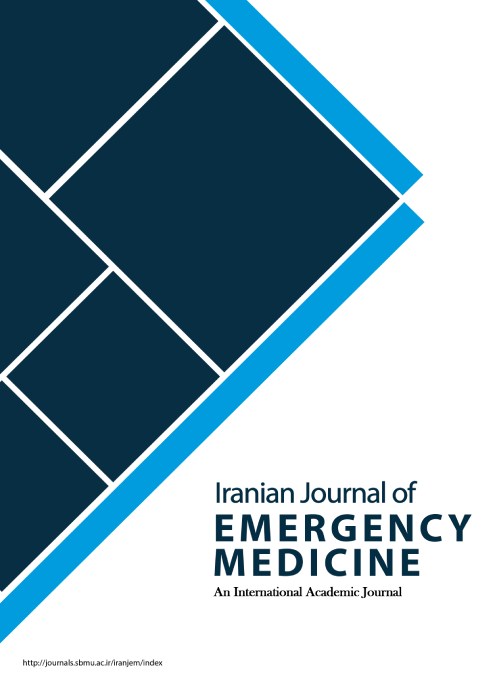Which Stroke Patients are Suitable for Endovascular Treatment in Emergency Department?
Author(s):
Article Type:
Letter (بدون رتبه معتبر)
Abstract:
Stroke makes up a significant part of causes for emergency department (ED) visits. This complication can be accompanied by a desirable outcome in case of rapid diagnosis and proper treatment intervention. However, in case of delay in treatment, it will bring about many costs for the individual, his or her family and the health care system. Therefore, timely diagnosis is the first and major step in managing these patients in ED and after that, choosing the proper treatment method is the priority. Currently, various treatment methods are available for managing these patients, from palliative care to thrombolytic therapy and endovascular interventions and one of the major questions in treatment of acute brain stroke in ED is which patient is suitable for receiving which treatment? Endovascular intervention is a relatively new treatment method that can extract the blood clot from the brain vessels and various studies have shown that it is one of the most effective treatment interventions in management of brain stroke. Various studies have been published in favor of its benefits in recent years, which have resulted in changes in treatment guidelines of stroke patients in America and Europe and highlighting the role of endovascular interventions in them. However, this interventional treatment is considered an invasive method that can be accompanied by side effects and thus, for reaching maximum success in this method, efforts should be made to select patients who have a higher probably to benefit from this intervention. It has been said that if obstruction of a big vessel is the reason for brain stroke, the patient is the best candidate for intervention and endovascular treatment. In this situation, the most important duty of the ED physician is to identify the obstructed arteries. The most important diagnostic method that existing guidelines suggest in this regard is performing computed tomography (CT) angiography that shows the status of big arteries from the beginning of Aorta to the smallest arteries inside the brain. Some treatment centers do this only for cases with the probability of extensive brain stroke, but it is suggested to perform both brain CT scan and CT angiography for all stroke cases including mild cases; because these patients might be at risk of an upcoming extensive stroke. Some centers add CT perfusion technique to the brain CT scan and CT angiography (CTA) duo. Unfortunately, this technique is not available in most centers in Iran. However, in the advanced centers around the world it can be performed at the same time as brain CT scan and can show an accurate picture regarding the extent of the brain tissue involved and even the reversibility of the tissue involved in the stroke. Proper arteries for thrombectomy are the middle cerebral artery (MCA) branch of intracranial carotid, especially its horizontal part (M1) and in some cases after branching of the carotid (M2). In addition, with the advances made, extracranial carotid thrombectomy can also be done today. But anterior and posterior cerebral arteries (ACA and PCA) are almost never intervention candidates. Extensive studies including IMS-3, MR-CLEN, ESCAPE, EXTEND-IA, SWIFTPRIME, and PREVASCAT have been done with the aim of selecting the proper vessels and candidates of endovascular interventions, almost none of which have evaluated the possibility of performing thrombectomy of basilar artery. However, a study called BASICS has been done in this regard that has even reported the time of thrombectomy for basilar artery and its prognosis even better than the other arteries and most interventionist and stroke neurologists have gained a positive view to performing it. Overall, in the above-mentioned studies about 1700 patients underwent emergency thrombectomy and the success rate without performing CTA was about 40% and if aware of the artery involved via CTA, the success rate has been reported to be about 70%. Regarding processing the situations in which CTA cannot be performed it should be noted that after enabling thrombolytic therapy, using thrombectomy even without knowing the status of the arteries involved with techniques such as CTA, the success rate of treating patients with stroke increased from about 23% to at least 40%. Therefore, it seems that preparing the equipment for performing CTA before emergency thrombectomy should be seriously supported, at least in major hospitals of Iran. In addition, the presently available equipment such as CT scan device and neurology and angiography departments and the specialists in these fields should be employed effectively. If the CT scan device can be programmed in a way that when performing brain CT scan, CT angiography can also be performed simultaneously, the candidate patients for undergoing thrombectomy can be selected more properly and by using these solutions the rate of improvement in patients with brain stroke and thus, being relieved from paralysis and long-term problems might increase to 70%.
Language:
Persian
Published:
Iranian Journal of Emergency medicine, Volume:5 Issue: 1, 2018
Page:
4
magiran.com/p1792306
دانلود و مطالعه متن این مقاله با یکی از روشهای زیر امکان پذیر است:
اشتراک شخصی
با عضویت و پرداخت آنلاین حق اشتراک یکساله به مبلغ 1,390,000ريال میتوانید 70 عنوان مطلب دانلود کنید!
اشتراک سازمانی
به کتابخانه دانشگاه یا محل کار خود پیشنهاد کنید تا اشتراک سازمانی این پایگاه را برای دسترسی نامحدود همه کاربران به متن مطالب تهیه نمایند!
توجه!
- حق عضویت دریافتی صرف حمایت از نشریات عضو و نگهداری، تکمیل و توسعه مگیران میشود.
- پرداخت حق اشتراک و دانلود مقالات اجازه بازنشر آن در سایر رسانههای چاپی و دیجیتال را به کاربر نمیدهد.
دسترسی سراسری کاربران دانشگاه پیام نور!
اعضای هیئت علمی و دانشجویان دانشگاه پیام نور در سراسر کشور، در صورت ثبت نام با ایمیل دانشگاهی، تا پایان فروردین ماه 1403 به مقالات سایت دسترسی خواهند داشت!
In order to view content subscription is required
Personal subscription
Subscribe magiran.com for 70 € euros via PayPal and download 70 articles during a year.
Organization subscription
Please contact us to subscribe your university or library for unlimited access!


